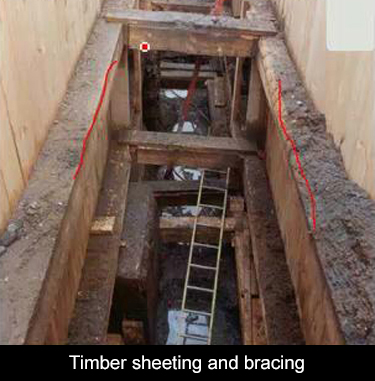Timber Sheeting
Here is a system that you have all seen out in the street. It is called Timber Sheeting. This is an extremely versatile method. While it may look somewhat thrown together, it's not. It's extremely sturdy and safe. And for reasonably shallow excavations it is a very flexible and very helpful solution. I just want to identify some of the features.

A member like this, a horizontal member, which is supporting the sheathing is called a whaler. In this case, the vertical sheathing are Timbers. This horizontal member is called a whaler and the vertical members in this case, are Timber sheets or timber planks. Here's a second whaler. This could be the whaler at level 2. And as you go farther down in the trench, you meet may need a third whaler.
The whalers should be strong enough to minimize the number of braces required. If you're trying to reach in and excavate or deliver a length of pipe or whatever activities you have, the braces or struts will be in the way.
What's very interesting here is how nicely the timber sheets can be cut around existing utilities. And this is a very helpful feature, because it works well with existing utilities. Some other features here, the timber planks are extended above the excavation so that you can attach a railing to to provide security.
Here's a ladder which provides quick egress to the excavation. These are very important safety features. This looks like a length of suction hose so that any water that is accumulating inside the trench can be pumped away.
I've enlarged an area to show you the connection between two of the vertical planks. If you're not familiar with that shape, it's called tongue and groove. And it is a very tight way of joining two wood shapes. You would typically find this in cabinet construction, or some furniture construction. What is it doing out here in the middle of the street?
In this project, many of the excavations are carried down to the water table, and sometimes slightly below the water table. This tongue and groove connection can give a water tight perimeter. A certain amount of water will certainly find its way in, but that is easily connected in a sump and pumped away.